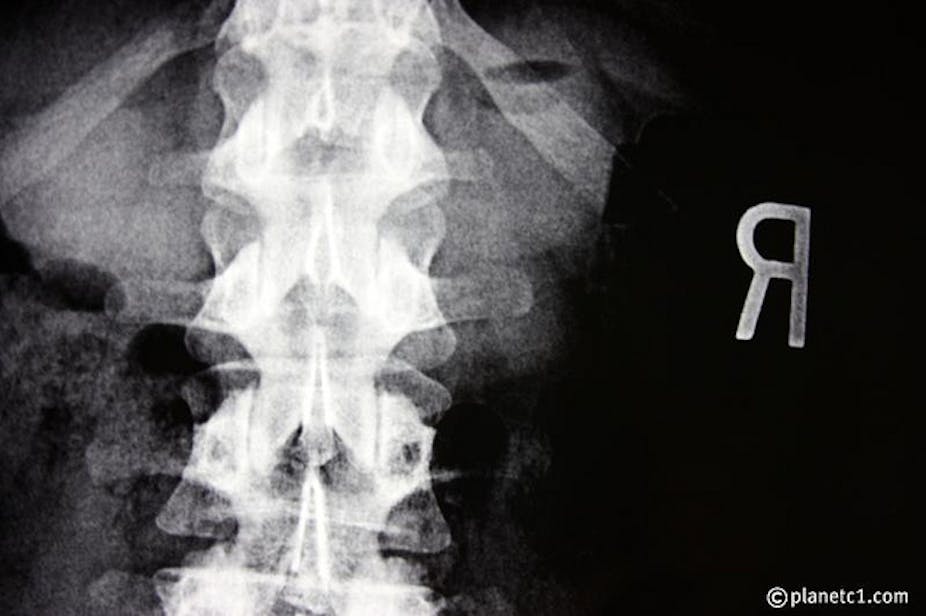Chiropractic has copped some criticism this week, with a group of prominent Australian doctors and scientists urging Central Queensland University to reverse its decision to offer a chiropractic degree from 2012. The group claims chiropractic isn’t based on evidence and therefore shouldn’t be taught at university.
As a chiropractor and academic, you’d expect me to defend my profession, so let’s consider the evidence.
Chiropractic therapy encompasses massage, exercise, advice, electrophysical therapies, sports therapy and tapping. But chiropractors are essentially health care professionals that specialise in spinal health.
Spinal manipulative therapy, which forms the bulk of most chiropractors’ day-to-day work, is a therapeutic intervention performed on vertebral joints in the spinal column to alleviate pain.
Chiropractors apply tension to the patient’s ligaments and then deliver a short, high-velocity thrust to increase the movement of the vertebrae. The therapy works by increasing vertebral mobility and improving blood flow to help reduce inflammation. It also changes nerve function which can result in many other effects.
So what does the evidence say about its efficacy? A Cochrane Review of spinal manipulation therapy for chronic low back pain shows that at minimum, it’s as effective as exercise therapy, standard medical care or physiotherapy.
(Interestingly, a Cochrane Review also shows that non steroidal anti-inflammatory drugs, which doctors commonly prescribe to alleviate back pain, only have a slight effect for back pain but also have many side effects and cause adverse reactions.)
Spinal manipulation therapy gained prominence in 2007 when the American College of Physicians and the American Pain Society recommended it as a treatment for chronic or subacute low back pain, alongside exercise therapy, acupuncture and yoga.
There have now been around 70 randomised control trials and 10 systematic reviews which support its use to treat lower back pain. Perhaps most notably, a 2004 study published in the British Medical Journal compared spinal manipulation therapy with exercise and reported better outcomes with spinal manipulation.
Evidence-based therapy
As with any health-care profession, it’s important that chiropractors restrict their therapies to those that are based on evidence. This doesn’t always occur and that’s where much of the medical profession’s criticism is levelled against chiropractic therapy.
Some chiropractors still strongly adhere to the early chiropractic teachings, that “vertebral subluxation” could cause many types of disease and conditions of the body. This is not the contemporary approach of chiropractic and shouldn’t be promoted.
Other chiropractors sometimes misconstrue improvements in a patient’s health or well-being as evidence that a treatment works. But, of course, there may have been other factors that helped achieve the effect the patient experienced, which was independent to the chiropractic treatment.
As with other scientific disciplines, the evidence base of chiropractic is constantly evolving, as researchers undertake new studies and trial the effects of different therapies.
When I started working at Macquarie University in the early 1990s, there was very limited evidence for chiropractic treatment for headache and migraine. Now, studies have shown that chiropractic can alleviate headaches, migraines and other conditions. Today’s chiropractors are very effective in alleviating neuromusculoskeletal disorders and medical practitioners should feel confident working with them.
Evidence-based education
Chiropractic has been taught at leading universities in Australia – Macquarie, Murdoch and RMIT – for more than 20 years and these institutions are at the forefront of international research to provide evidence-based therapies.
Macquarie University teaches an evidence-based program which includes subjects on orthopaedics, neurology, differential diagnosis, research methodology, critical thinking, ethics and jurisprudence. We also educate students on patient characteristics, preferences, and clinical observation. Students leave with more 5,000 hours of education and a Master’s degree.
Skeptics are right to question treatments and education that don’t have evidence to support their use. But all good health-care treatment providers will give patients evidence-based information to allow their patients to make informed choices. And that includes chiropractors.

